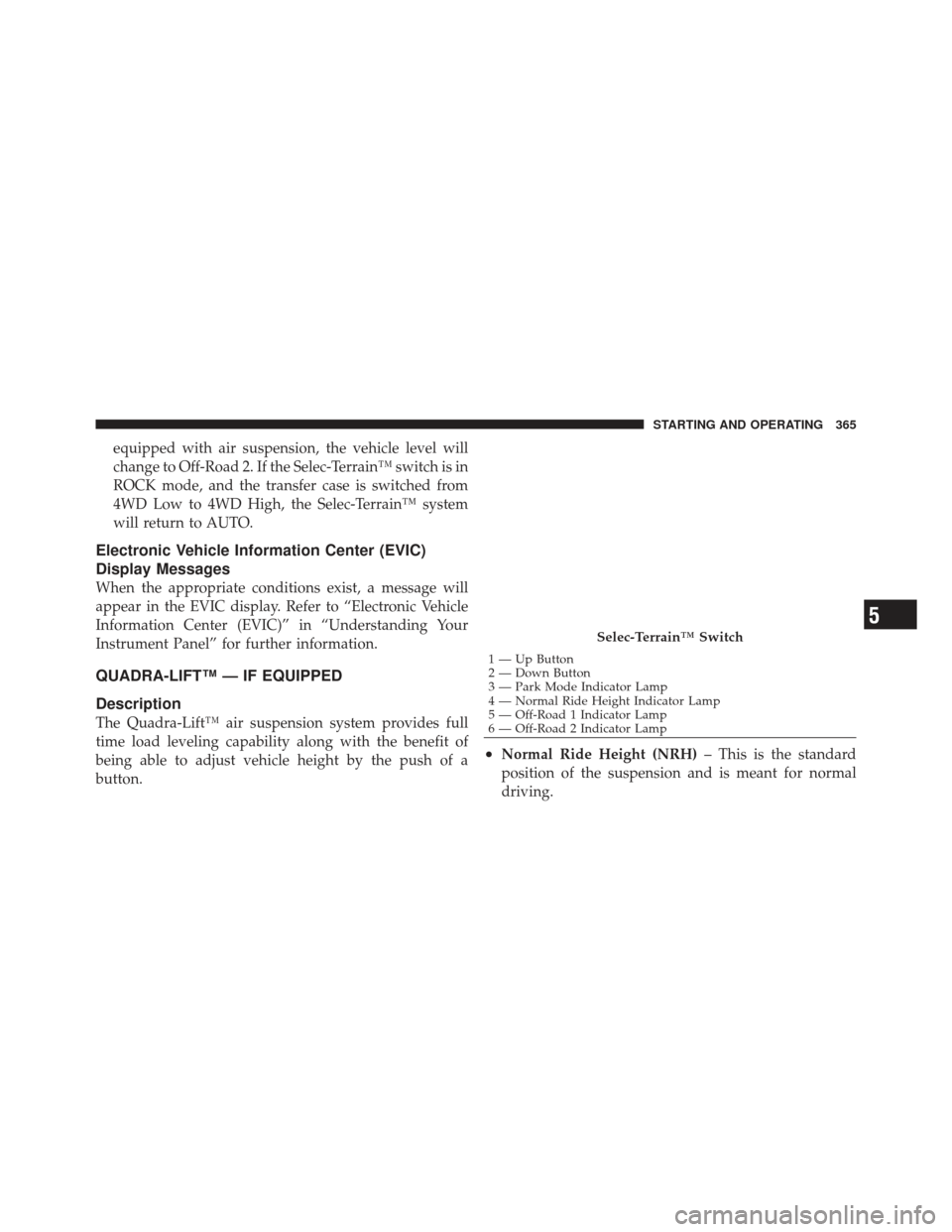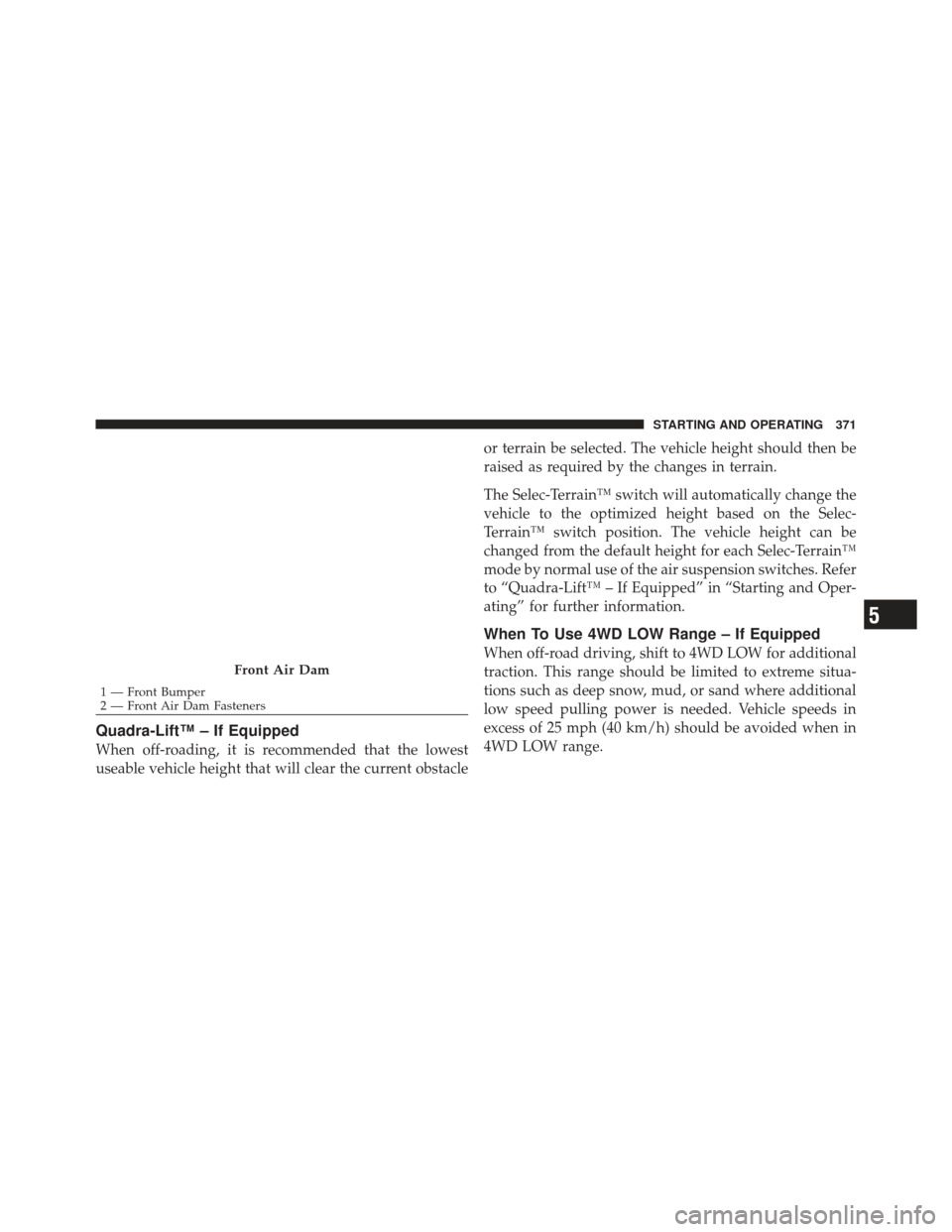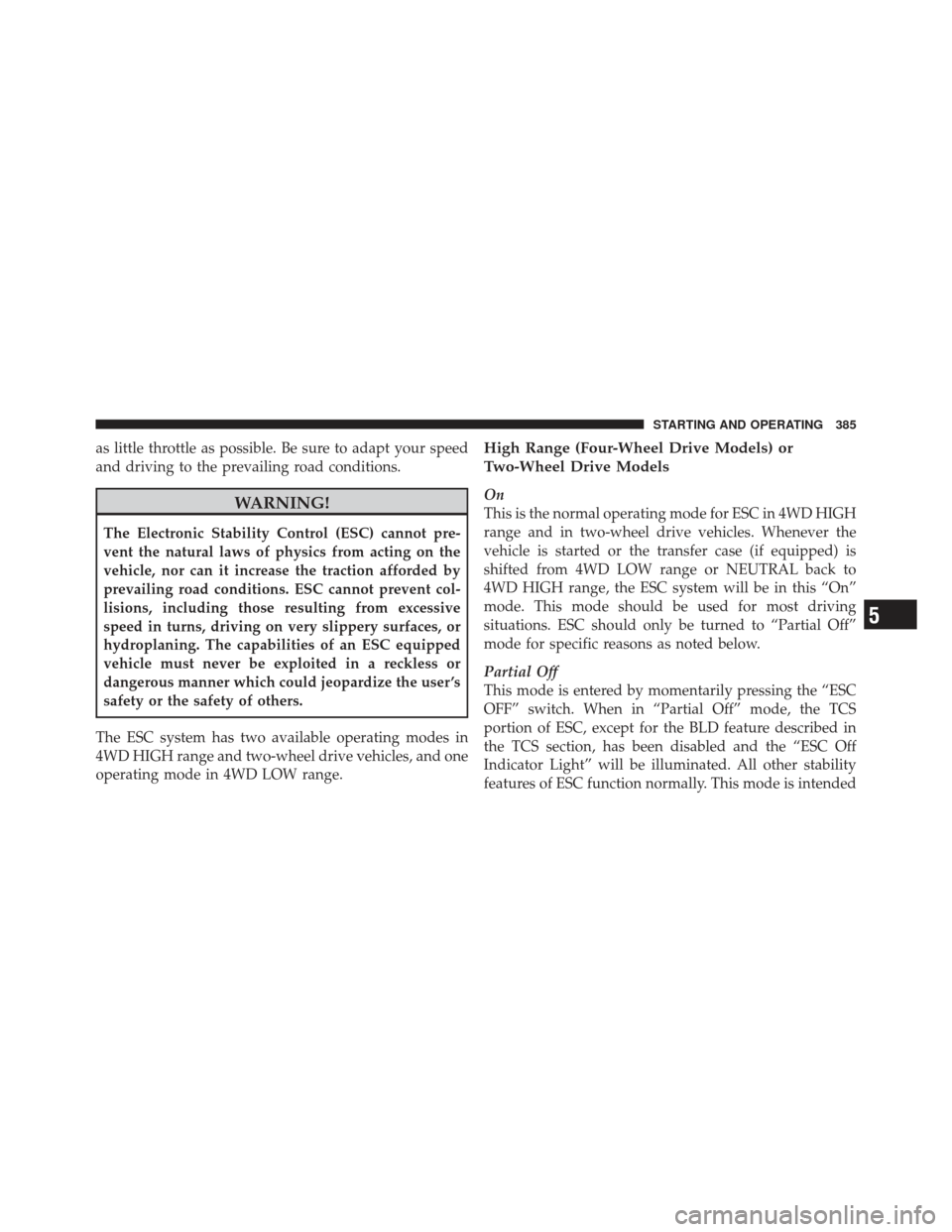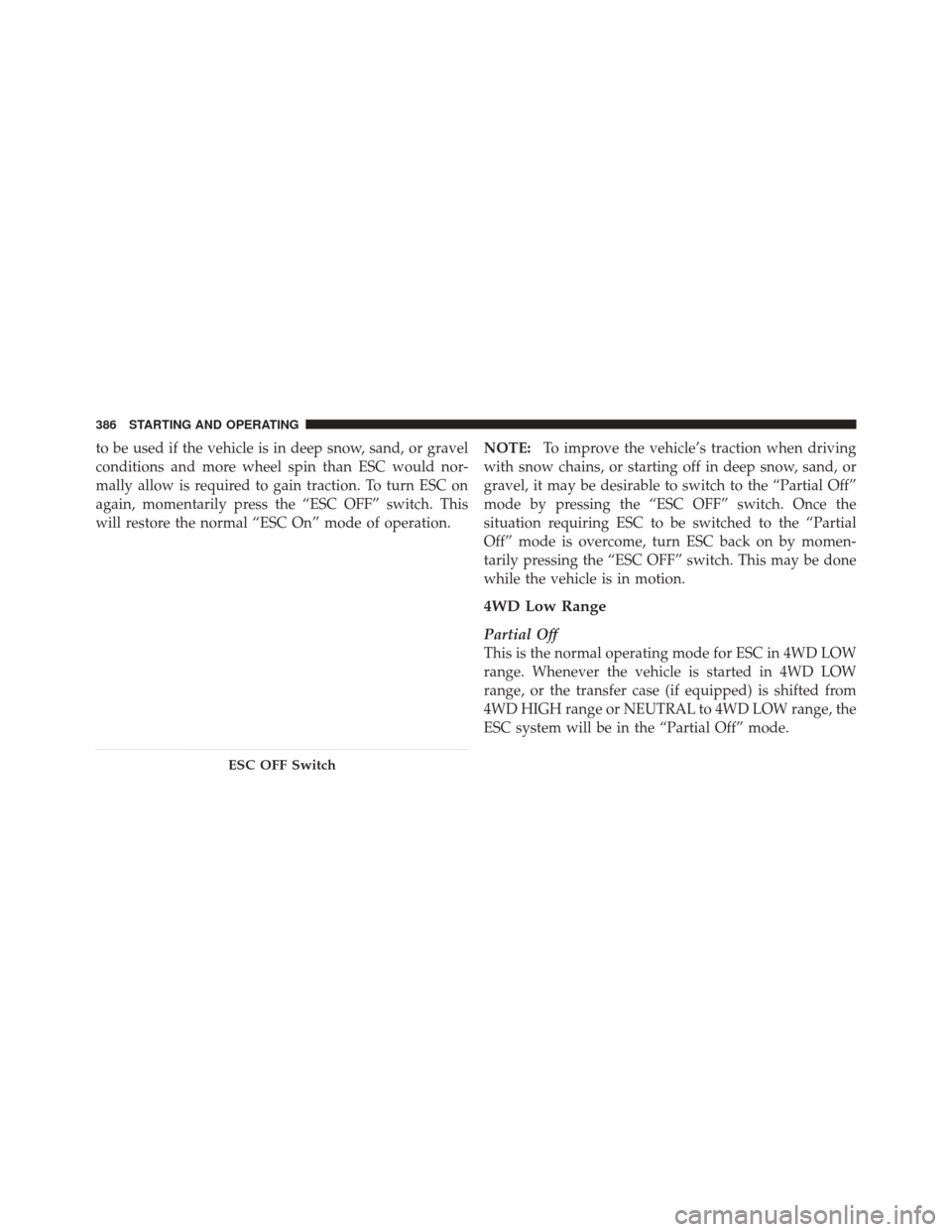Page 365 of 587
case and axle coupling differ in design, their operation is
similar. Follow the Quadra-Trac II�transfer case shifting
information, preceding this section, for shifting this
system.
SELEC-TERRAIN™ — IF EQUIPPED
Description
Selec-Terrain™ combines the capabilities of the vehicle
control systems, along with driver input, to provide the
best performance for all terrains.
Selec-Terrain™ consists of the following positions:
•Sport– Dry weather, on-road calibration. Only avail-
able in 4WD High range. Performance based tuning
that provides a rear wheel drive feel but with im-
proved handling and acceleration over a two-wheel
drive vehicle. The Electronic Stability Control will set
Selec-Terrain™ Switch
5
STARTING AND OPERATING 363
Page 366 of 587

to allow more driver control of vehicle while maintain-
ing safe handling controls. The vehicle will lower (if
equipped with Air Suspension) to Aero Mode in High
Range. 4WD Low is not available in SPORT mode, if
4WD Low is selected the Selec-Terrain™ will auto-
matically switch back to AUTO.
•Snow– Tuning set for additional stability in inclement
weather. Use on and off road on loose traction surfaces
such as snow. When in Snow mode (depending on
certain operating conditions), the transmission may
use second gear (rather than first gear) during
launches, to minimize wheel slippage. If equipped
with air suspension, the level will change to Normal
Ride Height (NRH) if the transfer case is in high range.
The level will change to Off-Road 1 if the transfer case
is in Low range.
•Auto – Fully automatic full time four-wheel drive
operation can be used on and off road. Balances traction with seamless steering feel to provide im-
proved handling and acceleration over two-wheel
drive vehicles. If equipped with air suspension, the
level will change to NRH.
•Sand/Mud
– Off road calibration for use on low
traction surfaces such as mud, sand, or wet grass.
Driveline is maximized for traction. Some binding
may be felt on less forgiving surfaces. The electronic
brake controls are set to limit traction control manage-
ment of throttle and wheel spin. If equipped with air
suspension, the level will change to Off-Road 1.
•Rock – Off-road calibration only available in 4WD
Low range. The vehicle is raised (if equipped with Air
Suspension) for improved ground clearance. Traction
based tuning with improved steer-ability for use on
high traction off-road surfaces. Activates the Hill De-
scent Control for steep downhill control. Use for low
speed obstacles such as large rocks, deep ruts, etc. If
364 STARTING AND OPERATING
Page 367 of 587

equipped with air suspension, the vehicle level will
change to Off-Road 2. If the Selec-Terrain™ switch is in
ROCK mode, and the transfer case is switched from
4WD Low to 4WD High, the Selec-Terrain™ system
will return to AUTO.
Electronic Vehicle Information Center (EVIC)
Display Messages
When the appropriate conditions exist, a message will
appear in the EVIC display. Refer to “Electronic Vehicle
Information Center (EVIC)” in “Understanding Your
Instrument Panel” for further information.
QUADRA-LIFT™ — IF EQUIPPED
Description
The Quadra-Lift™ air suspension system provides full
time load leveling capability along with the benefit of
being able to adjust vehicle height by the push of a
button.
•Normal Ride Height (NRH)– This is the standard
position of the suspension and is meant for normal
driving.
Selec-Terrain™ Switch
1 — Up Button
2 — Down Button
3 — Park Mode Indicator Lamp
4 — Normal Ride Height Indicator Lamp
5 — Off-Road 1 Indicator Lamp
6 — Off-Road 2 Indicator Lamp
5
STARTING AND OPERATING 365
Page 373 of 587

Quadra-Lift™ – If Equipped
When off-roading, it is recommended that the lowest
useable vehicle height that will clear the current obstacleor terrain be selected. The vehicle height should then be
raised as required by the changes in terrain.
The Selec-Terrain™ switch will automatically change the
vehicle to the optimized height based on the Selec-
Terrain™ switch position. The vehicle height can be
changed from the default height for each Selec-Terrain™
mode by normal use of the air suspension switches. Refer
to “Quadra-Lift™ – If Equipped” in “Starting and Oper-
ating” for further information.
When To Use 4WD LOW Range – If Equipped
When off-road driving, shift to 4WD LOW for additional
traction. This range should be limited to extreme situa-
tions such as deep snow, mud, or sand where additional
low speed pulling power is needed. Vehicle speeds in
excess of 25 mph (40 km/h) should be avoided when in
4WD LOW range.
Front Air Dam
1 — Front Bumper
2 — Front Air Dam Fasteners
5
STARTING AND OPERATING 371
Page 375 of 587

Standing Water
Avoid driving in standing water deeper than 20 inches
(51 cm), and reduce speed appropriately to minimize
wave effects. Maximum speed in 20 inches (51 cm) of
water is less than 5 mph (8 km/h).
Maintenance
After driving through deep water, inspect your vehicle
fluids and lubricants (engine oil, transmission oil, axle,
transfer case) to assure the fluids have not been contami-
nated. Contaminated fluid (milky, foamy in appearance)
should be flushed/changed as soon as possible to pre-
vent component damage.
Driving In Snow, Mud And Sand
In heavy snow, when pulling a load, or for additional
control at slower speeds, shift the transmission to a low
gear and shift the transfer case to 4WD LOW if necessary.
Refer to “Four-Wheel Drive Operation” in “Starting and
Operating” for further information. Do not shift to alower gear than necessary to maintain forward motion.
Over-revving the engine can spin the wheels and traction
will be lost.
Avoid abrupt downshifts on icy or slippery roads, be-
cause engine braking may cause skidding and loss of
control.
Hill Climbing
NOTE:
Before attempting to climb a hill, determine the
conditions at the crest and/or on the other side.
Before climbing a steep hill, shift the transmission to a
lower gear and shift the transfer case to 4WD LOW. Use
first gear and 4WD LOW for very steep hills.
If you stall or begin to lose forward motion while
climbing a steep hill, allow your vehicle to come to a stop
and immediately apply the brakes. Restart the engine,
and shift into REVERSE. Back slowly down the hill,
allowing the compression braking of the engine to help5
STARTING AND OPERATING 373
Page 376 of 587

regulate your speed. If the brakes are required to control
vehicle speed, apply them lightly and avoid locking or
skidding the tires.
WARNING!
If the engine stalls, you lose forward motion, or
cannot make it to the top of a steep hill or grade,
never attempt to turn around. To do so may result in
tipping and rolling the vehicle. Always back care-
fully straight down a hill in REVERSE gear. Never
back down a hill in NEUTRAL using only the brake.
Remember, never drive diagonally across a hill always
drive straight up or down.
If the wheels start to slip as you approach the crest of a
hill, ease off the accelerator and maintain forward motion
by turning the front wheels slowly. This may provide a
fresh “bite” into the surface and will usually provide
traction to complete the climb.
Traction Downhill
Shift the transmission into a low gear, and the transfer
case into 4WD LOW range. Let the vehicle go slowly
down the hill with all four wheels turning against engine
compression drag. This will permit you to control the
vehicle speed and direction.
When descending mountains or hills, repeated braking
can cause brake fade with loss of braking control. Avoid
repeated heavy braking by downshifting the transmis-
sion whenever possible.
After Driving Off-Road
Off-road operation puts more stress on your vehicle than
does most on-road driving. After going off-road, it is
always a good idea to check for damage. That way you
can get any problems taken care of right away and have
your vehicle ready when you need it.
374 STARTING AND OPERATING
Page 387 of 587

as little throttle as possible. Be sure to adapt your speed
and driving to the prevailing road conditions.
WARNING!
The Electronic Stability Control (ESC) cannot pre-
vent the natural laws of physics from acting on the
vehicle, nor can it increase the traction afforded by
prevailing road conditions. ESC cannot prevent col-
lisions, including those resulting from excessive
speed in turns, driving on very slippery surfaces, or
hydroplaning. The capabilities of an ESC equipped
vehicle must never be exploited in a reckless or
dangerous manner which could jeopardize the user ’s
safety or the safety of others.
The ESC system has two available operating modes in
4WD HIGH range and two-wheel drive vehicles, and one
operating mode in 4WD LOW range.
High Range (Four-Wheel Drive Models) or
Two-Wheel Drive Models
On
This is the normal operating mode for ESC in 4WD HIGH
range and in two-wheel drive vehicles. Whenever the
vehicle is started or the transfer case (if equipped) is
shifted from 4WD LOW range or NEUTRAL back to
4WD HIGH range, the ESC system will be in this “On”
mode. This mode should be used for most driving
situations. ESC should only be turned to “Partial Off”
mode for specific reasons as noted below.
Partial Off
This mode is entered by momentarily pressing the “ESC
OFF” switch. When in “Partial Off” mode, the TCS
portion of ESC, except for the BLD feature described in
the TCS section, has been disabled and the “ESC Off
Indicator Light” will be illuminated. All other stability
features of ESC function normally. This mode is intended
5
STARTING AND OPERATING 385
Page 388 of 587

to be used if the vehicle is in deep snow, sand, or gravel
conditions and more wheel spin than ESC would nor-
mally allow is required to gain traction. To turn ESC on
again, momentarily press the “ESC OFF” switch. This
will restore the normal “ESC On” mode of operation.NOTE:
To improve the vehicle’s traction when driving
with snow chains, or starting off in deep snow, sand, or
gravel, it may be desirable to switch to the “Partial Off”
mode by pressing the “ESC OFF” switch. Once the
situation requiring ESC to be switched to the “Partial
Off” mode is overcome, turn ESC back on by momen-
tarily pressing the “ESC OFF” switch. This may be done
while the vehicle is in motion.
4WD Low Range
Partial Off
This is the normal operating mode for ESC in 4WD LOW
range. Whenever the vehicle is started in 4WD LOW
range, or the transfer case (if equipped) is shifted from
4WD HIGH range or NEUTRAL to 4WD LOW range, the
ESC system will be in the “Partial Off” mode.
ESC OFF Switch
386 STARTING AND OPERATING